Astronauts in orbit view the earth, its atmosphere and the astronomical sky from altitudes ranging from 100 to 800+ nautical miles (160 to 1300 km.) above mean sea level, well above many of the restrictions of the ground-based observer. They are skilled in accurate observations, their eyesight is excellent, they have an intimate familiarity with navigational astronomy and a broad understanding of the basic physical sciences. Their reports from orbit of visual sightings therefore deserve careful consideration.
Between 12 April 1961 and 15 November 1966, 30 astronauts spent a total of 2503 hours in orbit. (see Tables 1 and 2 ) During the flights the astronauts carried out assigned tasks of several general categories, viz: defense, engineering, medical, and scientific. A list of the assigned tasks that were part of the Mercury program is provided in Table 3 to give an idea of the kinds of visual observations the astronauts were asked to make.
As a part of the program, debriefings were held following each U.S. mission. At these sessions, the astronauts were questioned by scientists involved in the design of the experiments about their observations, unplanned as well as specifically assigned. The debriefings complemented on-the-spot reports made by the astronauts during the mission in radio contacts with the ground-control center. In this way, a comprehensive summary was obtained of what the astronauts had seen while in orbit.
This chapter discusses the conditions under which the astronauts observed, with particular reference to the Mercury and Gemini series, and the observations, both planned and unplanned made by them. The
| Name | Total Time In Orbit | Flight Designation* |
|
| HOURS | MINUTES | ||
| Aldrin | 94 | 34 | GT-12 |
| Armstrong | 10 | 42 | GT-8 |
| Borman | 330 | 55 | GT-7 |
| Belayeyev | 27 | 2 | Voshkod II |
| Bykovsky | 119 | 6 | Vostok V |
| Carpenter | 4 | 56 | MA-7 |
| Cernan | 72 | 21 | GT-9 |
| Collins | 70 | 47 | GT-10 |
| Conrad | 262 | 13 | GT-5, GT-11 |
| Cooper | 225 | 16 | MA-9, GT-5 |
| Feoktisov | 24 | 17 | Voshkod I |
| Gagarin | 1 | 48 | Vostok I |
| Glenn | 4 | 56 | MA-6 |
| Gordon | 71 | 17 | GT-11 |
| Grissom | 5 | 10 | MR-4, GT-3 |
| Komarov | 24 | 17 | Voshkod I |
| Leonov | 27 | 2 | Voshkod II |
| Lovell | 425 | 29 | GT-7, GT-12 |
| McDivitt | 97 | 50 | GT-4 |
| Nikoyalev | 94 | 35 | Vostok III |
| Popovich | 70 | 57 | Vostok IV |
| Schirra | 35 | 4 | MA-8, GT-6 |
| Scott | 10 | 42 | GT-8 |
| Shepherd | 0 | 15 | MR-3 |
| Stafford | 98 | 12 | GT-6, GT-9 |
| Tereshkova | 70 | 50 | Vostok VI |
| Titov | 25 | 18 | Vostok II |
| White | 97 | 50 | GT-4 |
| Yegorov | 24 | 17 | Voshkod I |
| Young | 75 | 41 | GT-3, GT-10 |
| Total (for 30 astronauts) | 2503 | 39 | Total Man-flights 37 |
|
Duration |
Altitude (Statute Miles) |
||||||
| Flight | Astronauts | Launch Date | Number of Revolutions | Hr. | Min. | Perigee | Apogee |
| Vostok I | Gagarin | 12 April 61 | 1 | 1 | 48 | 110 | 187 |
| MR-3 | Sheperd | 5 May 61 | Suborbital | 15 | 116 | - | |
| MR-4 | Grissom | 21 July 61 | Suborbital | 16 | 118 | - | |
| Vostok II | Titov | 6 Aug 61 | 17 | 25 | 18 | 100 | 159 |
| MA-6 | Glenn | 20 Feb 62 | 3 | 4 | 56 | 100 | 162 |
| MA-7 | Carpenter | 24 May 62 | 3 | 4 | 56 | 99 | 167 |
| Vostok III | Nikoyalev | 11 Aug 62 | 64 | 94 | 35 | 114 | 156 |
| Vostok IV | Popovich | 12 Aug 62 | 48 | 70 | 57 | 112 | 158 |
| MA-8 | Schirra | 3 Oct 62 | 6 | 9 | 13 | 100 | 176 |
| MA-9 | Cooper | 15 May 63 | 22 | 34 | 20 | 100 | 166 |
| Vostok V | Bykovsky | 14 June 63 | 81 | 119 | 6 | 107 | 146 |
| Vostok VI | Tereshkova | 16 June 63 | 48 | 70 | 50 | 113 | 144 |
| Voshkod I | Komarov, Yegorov, Feoktisov | 16 Oct 64 | 16 | 24 | 17 | 110 | 255 |
| Voshkod II | Belayayev, Leonov | 18 Mar 65 | 17 | 27 | 2 | 107 | 307 |
| GT-3 | Grissom, Young | 23 Mar 65 | 3 | 4 | 54 | 100 | 139 |
| GT-4 | McDivitt, White | 3 Jun 65 | 63 | 97 | 50 | 100 | 175 |
| GT-5 | Cooper, Conrad | 21 Aug 65 | 120 | 190 | 56 | 100 | 189 |
| GT-6 | Schirra, Stafford | 15 Dec 65 | 16 | 25 | 51 | 100 | 140 |
| GT-7 | Borman, Lovell | 4 Dec 65 | 205 | 330 | 55 | 100 | 177 |
| GT-8 | Armstrong, Scott | 16 Mar 66 | 7 | 10 | 42 | 99 | 147 |
| GT-9 | Stafford, Cernan | 3 Jun 66 | 46 | 72 | 21 | 99 | 144 |
| *GT-10 | Young, Collins | 18 Jul 66 | 44 | 70 | 47 | 99 | 145 |
| *GT-11 | Conrad, Gordon | 12 Sept 66 | 45 | 71 | 17 | 100 | 151 |
| GT-12 | Lovell, Aldrin | 11 Nov 66 | 59 | 94 | 34 | 100 | 185 |
| Total (of 24 flights) | 934 | 1457 | 56 | ||||
| Assigned Observations | Mission Numbers | Equipment | Results |
| Observe dimlight phenomena to increase our knowledge of auroras, faint comets near the sun, faint magnitude limit of stars, gegenschein, libration, clouds, meteorite flashes, zodiacal light. | 6,9 | Unaided eye, Camera, Voasmeter Photometer |
MA-6 not dark adapted.
MA-9 saw zodiacal light and airglow. Photographs of airglow obtained. |
| Measure atmospheric attenuation of sunlight and starlight intensity. | 6 | Voasmeter photometer | No result |
| Determine intensity, distribution, structure, variation and color of visual airglow. | 6,7,8,9 | Unaided eye with 5577-A filter Camera |
Airglow was seen on all flights; was photographed on MA-9.
Filter was used on MA-7. |
| Determine danger of micrometeorite impact and relate to spacecraft protection. | 6,7,8,9 | Visual and microscopic inspection | One impact found on MA-9 window. |
| Determine intensity, distribution, structure, variation and color of red airglow. | 8,9 | Unaided eye | Detected visually on MA-8; confirmed visually on MA-9 |
| Test and refine theory of optics vis à vis refraction of images near horizon. | 6,7,9 | Unaided eye, Camera |
Photographs MA-6, MA-7.
Visual MA-7, MA-9. |
| Assigned Observations | Mission Numbers | Equipment | Results |
| Determine nature and source of the so-called "Glenn effect" or particles. | 6,7,8,9 | Unaided eye, Camera | Discovered on MA-6; all others saw visually; MA-7 photographs. |
| Compare observations of albedo intensities, day and night times with theory and refine theory. | 6 | Unaided eye, Voasmeter photometer | Not obtained due to instrument malfunction |
| Photograph cloud structure for comparison with Liros photos. Improve map forecasts. | 6,7,8,9 | Camera with filters of various wavelengths | MA-8 and MA-9 obtained scheduled photographs |
| Take general weather photographs and make general meteorological observation for comparison with those made by Liros satellite. | 6,7,8,9 | Unaided eye, Camera | All obtained photographs. |
| Determine best wavelength for definition of horizon for navigation. | 7,9 | Camera with red and blue filters. | Successful. The red photographs were sharper; the blue more stable. |
| Obtain ultraviolet spectra of Orion stars for extension of knowledge below 3000 A | 6 | Ultraviolet spectrograph. | Spectra were obtained but window did not transmit to expected wavelength. |
| Assigned Observations | Mission Numbers | Equipment | Results |
| Identify geological and topographical features from high altitude photographs for comparison with surface features as mapped. | 6,7,8,9 | Unaided eye, camera | Photographs obtained on all. Quality best on MA-9. |
| Identification of photographs of surface targets by comparison with known geological features. | 8 | Unaided eye, Camera | Few selected ones obtained. Quality fair. |
The conditions under which astronauts made their observations are similar to those which would be encountered by one or two persons in the front seat of a small car having no side or rear windows and a partially covered, smudged windshield.
The dimensions and configuration of the spacecraft windows, which are inclined 30° towards the astronauts, are given in Figure 1. The windows are small and permit only a limited forward (with respect to the astronauts) view of the sky. The sphere of view around a capsule in space contains 41,253 square degrees, but the astronauts are able to see only 1200 square degrees or about 3% of that sphere; and only 6% of a hemisphere. The spacecraft can be turned to enable the astronauts to see a different area than the one they face, but fuel must be conserved and maneuvers were not usually made simply to provide a better or different view. In effect, therefore, 94% of the solid angle of space around the capsule was, at any given moment, out of view of the spacecraft occupants.
In addition to this restricted field of vision, the windows themselves were never entirely clean, and the difficulties imposed by the scattering of light from deposits on the window were severe. The deposits apparently occurred during the firing of third-stage rockets, when gases were swept past the windows. Attempts were made to eliminate the smudging by use of temporary covers jettisoned once
There were differences from one flight to another in viewing quality of the windows and from one window to the other on the same flight. For example on Gemini 7, the command pilot in the left seat was able to identify stars to magnitude 6 during satellite night, while the pilot in the right seat was limited to magnitude 4.4. The difference of 1.6 magnitudes (a factor of 4.4) was undoubtedly due to a difference in window transmission. It should be noted that stars as faint as magnitude 6 can be identified from the ground only under superb conditions (absence of artificial lights and moonlight plus a very clear sky).
The astronauts who had relatively clean windows often referred to the appearance of the night sky as seen in orbit, as similar to that seen by the pilot of a jet aircraft at 40,000 feet.
The smudged windows affected the visibility of objects during satellite night due to the decrease in the window transmission, but the effect was even more serious during satellite daytime when the glare from the light scattered by the smudge often was so bright as to destroy the contrast by which objects could be easily distinguished.
Satellites in orbit are subjected to atmospheric drag, which ultimately causes them to reenter the earth's atmosphere, often producing a brilliant display as they do so. Reentries are sometimes reported as UFOs. Ore recent case in particular stands as an example of a reentry reported as an UFO and later identified tentatively as the reentries of Agena of Gemini 11 (Case 11) and Zond IV (sec Section VI, Chapter 2).
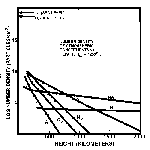
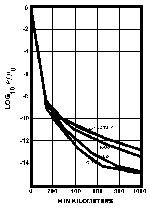
If the earth were a perfect sphere and if there were no atmospheric drag, satellites in orbit around our planet would behave according to Kepler's Laws of planetary orbits around the sun. Table 4 is derived from Kepler's third law. The relationship between the period in seconds (p) and the mean distance in centimeters (r) is expressed by:
| p2 = |
4 pi2 r3
G ME |
= 0.9906 x 10-19 r3 |
| S = |
2 · Pi · r p |
= |
1.996 x 1010 sqrt(r) |
The angular velocity of a satellite, (proportional to the reciprocal of the period), decreases as the radius of the orbit
| Radius of Orbit | Period of Orbit Around Earth | Speed | |||
| r(km.) | P(secs.) | P(mins.) | P(hrs.) | P(days) | S(km/sec) |
| 6378+200 | 5310 | 88.5 | 7.78 | ||
| 6378+500 | 5677 | 94.6 | 7.61 | ||
| 6378+1000 | 6307 | 105.1 | 7.35 | ||
| 6378+35,862 | 86,400 | 24 | 3.07 (geostationary) | ||
| 6378+378,025 | 2372 x 106 | 27.4 | 1.02 (moon) | ||
Atmospheric drag slows the satellite speed, especially near perigee, and this causes the satellite to swing out to a smaller subsequent apogee. The orbit contracts and becomes more circular. Eventually the satellite descends to an altitude where the drag causes the satellite to reenter the earth's atmosphere.
Table 5 shows some calculated decelerations for a massive object such as a satellite, and a small meteoritic particle of 0.1 cm. diameter and density of 0.4 gm/cm-3 (mass = 2.09 x l0-4 grams). At 160 km. (the perigee of many of the manned space-craft orbits) the deceleration on the spacecraft is not trivial (0.017 cm/sec-2) and the orbit will slowly, but surely degrade to a reentry. Of interest in connection with the observation of small particles by the astronauts is the differential acceleration between the spacecraft and the particles. In a period of ten seconds small particles will "drift" away from the spacecraft a distance of some meters. Typical relative speeds of small particles with respect to the spacecraft have been estimated by the astronauts as 1 or 2 m/sec.
During reentry, the spacecraft and fragments flaked off of its surface become luminous, producing the displays sometimes reported as UFOs. A satellite reentry normally occurs along a grazing path, but the trajectories of meteorites are more radial, and therefore the duration of luminosity is usually no more than two to three seconds.
Table 6 shows the masses of objects for given apparent stellar magnitudes and varying periods of luminosity, calculated on the assumption that all the orbital kinetic energy of the object is
| Satellite | Small Particle | |||
| MASS (gm) | 3.63x106 | 2.09x10-4 | ||
| DIAMETER (cm) | 400 | 0.1 | ||
| RATIO, AREA/MASS | 0.00865 | 37.5 | ||
| ALTITUDE (km) | 160 | 200 | 160 | 200 |
| AIR DENSITY | 8.271x10-13 | 1.098x10-13 | 8.271x10-13 | 1.098x10-13 |
| DECELERATION (cm-sec-2) | 1.741x10-2 | 2.311x10-3 | 18.86 | 2.50 |
| Separation from craft after: | ||||
| 1 sec | 1.25 cm | |||
| 10 sec | 125 cm | |||
| 100 sec | 12500 cm | |||
Astronauts have reported observations they have made, while in orbit, of artifacts (defined here as man-made objects) as well as observations made of natural geophysical and astronomical phenomena during flight. It is among the observations of artifacts that unidentified sightings are most likely to occur, if at all.
A man-made satellite moving slowly against the star background has become a familiar sight. Even though the sun may be below the observer's horizon, the satellite, some hundreds of kilometers above the earth's surface catches the sun's rays and reflects them back to the ground-based observer. Since artifact sightings made from a spacecraft are frequently also the result of reflection of sunlight from a solid object, the question of the brightness of objects illuminated by the sun is pertinent to the consideration of observations from the space vehicles. One observation was reported of a dark object against the bright day sky (window?) background (see Section 9 of this chapter).
Satellite brightness, as observed from the ground, is usually given in apparent stellar magnitudes because of the convenience of comparing a satellite with the star background. The unaided eye on a clear moonless night can perceive magnitudes as faint as between +5 and +6. Telescopic satellite searches are able to detect fainter magnitudes; for example, the United Kingdom optical tracking stations can acquire satellites as faint as +9 (Pilkington, 1967 ). The brightness of artificial satellites and their visual acquisition has been discussed by several writers (Pilkington, 1967; Roach, J.R., 1967; Sumners, et al, 1966; and Zink, 1963).
Plots of the apparent visual magnitude of sun-illuminated objects as a function of slant distance (in kilometers) and of diameter (in centimeters) of the object are shown in Figs. 4 and 5 respectively.
DURATION OF VISIBILITY
(Initial speed = 30 km/sec.) |
|||
| APPARENT MAGNITUDE | 1 Second | 10 Seconds | 100 Seconds |
| 5 | 0.000078 gm. | 0.00078 gm. | 0.0078 gm. |
| 0 | 0.0078 gm. | 0.078 gm. | 0.78 gm. |
| -5 | 0.79 gm. | 7.8 gm. | 78 gm. |
| -10 | 79 gm. | 780 gm. | 7800 gm. |
DURATION OF VISIBILITY
(Initial speed = 7.5 km/sec.) |
|
| APPARENT MAGNITUDE |
100 Seconds |
| -5 | 1000 gm. |
| -10 | 100,000 gm. |
Fig. 5 is pertinent to the observation of the Glenn "fireflies" and the "uriglow" (see pp. 37, 38 this chapter) and shows that seen close up, i.e.; at 1 to 10 m., even very small sun-illuminated particles are dazzlingly bright.
Fig. 5. Apparent magnitude of spheres illuminated by the sun as a function of the diameter of the spheres. It is assumed that the distance from the observer to the spheres is 1 meter (Curve A) and 10 meters (Curve B). See equation (1) p. 286.
Fig. 4. The apparent visual magnitude of objects illuminated by the sun as a function of distance between observer and object. Curve A is for a sphere of 1 meter diameter (see equation 1 in text). Curve B is for the OSO spacecraft assuming as albedo of 0.4, a window transmission of 0.5, a solar cosine of 0.5, and the OSO sails broad-side to the observer (Roach, J.R., 1967.)
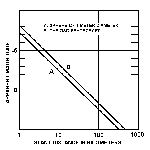
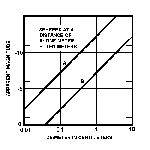
Reports by the Mercury astronauts that they were able to observe very small objects on the ground aroused considerable interest in the general matter of the visual acuity of the astronauts. One of the criteria in the selection of the astronauts to begin with was that they have excellent eyesight, but it was not known whether their high level of visual acuity would be sustained during flight. Therefore, experiments were designed to test whether any significant change in visual acuity could be detected during extended flights. These experiments were carried out during Gemini 5 (8 days) and Gemini 7 (14 days).
An in-flight vision tester was used one or more times per day, and the results were compared with preflight tests made with the same equipment. In addition, a test pattern was laid out on the ground near Laredo, Tex. for observation during flight. The reader is referred to the original report for the details of the carefully controlled experiments, which led to the following conclusions:
Data from the inflight vision tester show that no change was detected in the visual performance of any of the four astronauts who composed the crews of Gemini 5 and Gemini 7. Results from observations of the ground site near Laredo, Tex., confirm that the visual performance of the astronauts during space flight was within the statistical range of their preflight visual performance and demonstrate that laboratory visual data can be combined with environmental optical data to predict correctly the limiting visual capability of astronauts to discriminate small objects on the surface of the earth in the daylight.
| ASTRONAUT |
Preflight |
Postflight |
||||
| O.S. | O.D. | O.S. | O.D. | |||
| Cooper | Far Near |
20/15 20/15 |
20/15 20/15 |
20/15 20/20 |
20/15 20/20 |
|
| Conrad | Far Near |
20/15 20/15 |
20/15 20/15 |
20/12.5 20/15 |
20/12.5 20/15 |
|
| Borman | Far Near |
20/15 20/15 |
20/15 20/15 |
20/15 20/15 |
20/15 20/15 |
|
| Lovell | Far Near |
20/15 20/15 |
20/15 20/15 |
20/15 20/15 |
20/15 20/15 |
|
At the same time, a hindrance to top observing performance was that the astronauts were never thoroughly dark-adapted for any length of time. Good dark-adaptation is achieved some 30 minutes after the eyes are initially subjected to darkness. A typical orbit period was 90 minutes during which the astronauts were in full sunlight for 45 minutes and in darkness for 45 minutes. The astronauts therefore were fully dark adapted for only 15 minutes out of every 90 minute orbit (assuming no cabin lights).
The Night Airglow
The first American to go into orbit, astronaut John Glenn, (MA-6) reported observing an annular ring around the horizon during satellite
Ground-based studies of the night airglow show that it is composed of
a number of separate and distinct layers. The layer visible to the
astronauts is a narrow one at a height of about 100 km. which, seen
tangentially by the astronauts, is easily visible. (It can be seen
from the earth's surface only marginally but is easily measured with
photometers.)
At a height of about 250 km. there is another airglow layer which is
especially prominent in the tropics. It is probable that airglow from
this higher level was seen on two occasions. Astronaut Schirra (MA-8)
reported a faint luminosity of a patchy nature while south of
Madagascar, looking in the general direction of India (NASA SP-12,
page 53, 3 October 1962) as follows:
A smog-appearing layer was evident during the fourth pass while I was
in drifting flight on the night side, almost at 32°
south latitude. I would say that this layer represented about a
quarter of the field of view out of the window and this surprised me.
I thought I was looking at clouds all the time until I saw stars down
at the bottom or underneath the glowing layer.
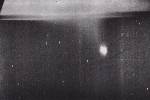
Plate 13: Airglow from orbit
Click on Thumbnail to see Full-size image.

Plate 14: Airglow from rocket
Click on Thumbnail to see Full-size image.
Seeing the stars below the glowing layer was probably the biggest surprise I had during the flight. I expect that future flights may help to clarify the nature of this band of light, which appeared to be thicker than that reported by Scott Carpenter.
All the astronauts of later flights knew of astronaut Schirra's
sighting, but on only one other occasion was an observation made of a
similar phenomenon. At 05h llm 34s into the Mercury flight, astronaut
Cooper reported:
"Right now I can make out a lot of luminous
activities in an easterly direction at 180° yaw ... I wouldn't
say it was much like a layer. It wasn't distinct and it didn't last
long; but it was higher than I was. It wasn't even in the vicinity of
the horizon and was not well defined. A good size." I had occasion to
query him a bit more about his report during a debriefing following
the flight:
Roach: More like a patch?
Cooper: Smoother. It was a good sized area.
Roach: You didn't feel this had a discrete shape?
Cooper: It was very indistinct in shape. It was a faint glow with a reddish brown cast.
The hypothesis has been advanced that the two observations are of the tropical airglow. We know from ground observations of this phenomenon that it is often observed to be patchy. The spectroscopic composition of the phenomenon is about 80% 6300Å and 20% 5577*Aring;. If a bright patchy region of 1000 km. extension (horizontal) came into the view of an astronaut it could appear to be "smog appearing" (Schirra) or "reddish brown" (Cooper). The tropical airglow was relatively bright during 1962 and 1963, and became quite faint during 1964 to 1966, the sunspot minimum. During 1967, as the new sunspot maximum approached, the tropical airglow underwent a significant enhancement. This solar
The Aurora
The Mercury and Gemini orbits were confined within geographic latitudes of 32° N and 32° S. Since the auroral zones are at geomagnetic latitudes of 67° N and 67° S it would seem unlikely that auroras could be seen by the astronauts. However two circumstances were favorable for such sightings. First, the "dip" of the horizon at orbital heights puts the viewed horizon at a considerable distance from the sub-satellite point. For example at a satellite height of 166km. (perigee for GT.-4) the dip of the horizon is about 13° and at a height of 297 km. (apogee for GT-4) it is about 17°. Second, the auroral zone, being controlled by the geomagnetic field, is inclined to parallels of geographic latitude as illustrated in Plate 15. Nighttime passes over the eastern United States or over southern Australia bring the spacecraft closest to the auroral zone. On several occasions auroras were seen in the Australia-New Zealand region. Plate 16 (Fig. 32-7 of NASA SP-121) shows a reproduction of a sketch made by the Gemini 7 crew. An auroral arch is seen below the airglow layer.
The Visibility of Stars
Satellite orbits are at a minimum height of about 160 km. where the
"sky" above is not the familiar blue as it is from the earth's
surface. Since the small fraction of the atmosphere above the
space-craft produces a very low amount of scattering, even in full
sunlight, it was anticipated that the day sky from a spacecraft would
therefore display the full astronomical panoply. This was decidedly
notthe case. All the American astronauts have expressed
themselves most forcefully that during satellite daytime, i.e., when
the sun is above the horizon, they could not see the stars, even the
brighter ones. Only on a few occasions, if the low sun was completely
occulted by the spacecraft were some bright stars noted. The
inability to observe the stars as anticipated is ascribed to two
reasons; (1) the satellite window surfaces scattered light from the
oblique sun or even from the
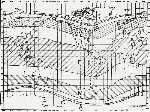
Plate 15: Auroral zone diagram
Click on Thumbnail to see Full-size image.
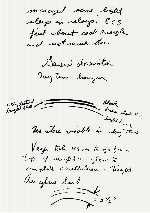
Plate 16: Auroral arch sketch
Click on Thumbnail to see Full-size image.
Mention has already been made of the dispersion in star visibility during satellite night because of the smudging of the windows. Under the best window conditions the astronomical sky is reported to be similar to that from an aircraft at 40,000 ft. Under the particularly poor conditions of Mercury 8, astronaut Schirra, who is very familiar with the constellations, could not distinguish the Milky Way.
Meteors
In general, meteors become luminous below 100 km., well below any stable orbit. Although organized searches for meteor trails were not part of the scientific planning of the NASA programs, sporadic observations were made by the astronauts who reported that the meteor trails could be readily distinguished from lightning flashes. Because of their sporadic nature, these observations cannot be systematically compared with the ground-observed statistics of the known variation of meteors during the year as the earth crosses the paths of inter- planetary debris. However, Gemini 5 was put into orbit shortly after the peak of the August Leonid shower and ground observations of the shower were confirmed in a rough way when astronauts Cooper and Conrad observed a significant number of meteor flashes.
The Zodiacal Light Band
Two factors tend to offset each other in the observation of the zodiacal light band from a spacecraft. A favorable factor is that the zodiacal band gets very rapidly brighter as it is observed as close as some 5° or 6° to the sun, as is possible from spacecraft in contrast with the twilight restriction on the earth's surface of about 25°. The ratio of brightness at an elongation of 5°, B(5), to that at 25°,8(25), is
|
B(5) B (25) |
= 50 |
The most convincing description of a visual sighting of the zodiacal band was by astronaut Cooper (Mercury 9). From his description, I concluded that he distinguished the zodiacal band some from the sun.
Twilight Bands
The satellite "day" for orbits relatively near the earth is about 45 mm. long. The sunrise and sunset sequence occurs during each satellite day. The bright twilight band extending along the earth's surface and centered above the sun is referred to by the astronauts as of spectacular beauty.
In the decade since the launching of Sputnik I (4 October 1957) a large number of objects have been put in orbit. With each launch, an average of five objects go into orbit. As of 1 January 1967, a total of 2,606 objects had been identified from 512 launchings, of which 1,139 were still in orbit and 1,467 had reentered. The objects in quasi-stable orbits are catalogued by the North American Air Defense Command (NORAD), and up-to-date lists of orbital characteristics are given annually in Planetary and Space Science (Quinn and King-Hele, 1967) from which tabular and graphic statistics have been prepared for this report. (Tables 7 and 8 and Fig. 6 ).
| Calendar Year | 1957 | 1958 | 1959 | 1960 | 1961 | 1962 | 1963 | 1964 | 1965 | 1966 | Total to date | Reentries during preceding year |
| Pieces put in orbit during calendar year | 5 | 12 | 15 | 50 | 297 | 190 | 204 | 329 | 950 | 554 | 2606 | |
| Decays as of: | ||||||||||||
| 1 Jan. 1963 | 5 | 8 | 10 | 22 | 64 | 92 | 201 | |||||
| 1 Jan. 1964 | 5 | 8 | 10 | 22 | 66 | 139 | 83 | 333 | 132 | |||
| 1 Jan. 1965 | 5 | 8 | 10 | 22 | 66 | 141 | 87 | 210 | 549 | 216 | ||
| 1 Jan. 1966 | 5 | 8 | 10 | 23 | 68 | 141 | 93 | 233 | 380 | 961 | 412 | |
| 1 Jan. 1967 | 5 | 8 | 10 | 23 | 71 | 142 | 98 | 241 | 455 | 414 | 1467 | 506 |
| Still in orbit as of 1 Jan. 1967 | 0 | 4 | 5 | 27 | 226 | 48 | 106 | 88 | 495 | 140 | 1139 | |
| Pieces put in Orbit |
Decayed | Still in Orbit (1 Jan. 1967) |
|
| Instrumented satellites | 643 | 379 | 264 |
| Separate rockets | 298 | 179 | 119 |
| Other fragments | 1665 | 909 | 756 |
| Total | 2606 | 1467 | l139 |
| Percent | 100.0 | 56.3 | 43.7 |
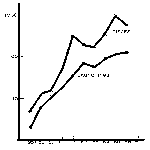
Proton III
An interesting example of an unexpected sighting of another space-craft was made by the Gemini 11 astronauts. Quoting from the transcript (GT-ll, tape 133, page 1)
We had a wingman flying wing on us going into sunset here, off to my left. A large object that was tumbling at about 1 rps and we flew -- we had him in sight, I say fairly close to us, I don't know, it could depend on how big he is and I guess he could have been anything from our ELSS* to something else. We took pictures of it.
The identification of the sighting (tape 209, page 2) was given as follows:
We have a report on the object sighted by Pete Conrad over Tananarive yesterday on the 18th revolution. It has been identified by NORAD as the Proton III satellite. Since Proton III was more than 450 kilometers from Gemini 11, it is unlikely that any photographs would show more than a point of light.
The pictures referred to are shown in enlargement in Plates 17 and 18.
The Proton III satellite and its rocket are included in the
P.A.S.S. listings under the numbers 1966-60A and 1966-60B with the
following characteristics:
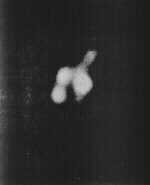
Plate 17: Gemini 11, Frame 10
Click on Thumbnail to see Full-size image.
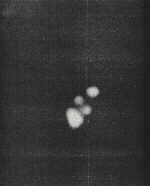
Plate 18: Gemini 11, Frame 11
Click on Thumbnail to see Full-size image.
* ELSS extravehicular life support system
| Satellite | Booster | |
| 1966-60A | 1966-608 | |
| Launch Date | 1966 July 6 | 1966 July 6 |
| Lifetime | 72.20 days | 46.33 days |
| Predicted Reentry Date | 16 Sept 1966 | 21 August 1966 |
| Shape | Cylinder | Cylinder |
| Weight | 12,200 kg. | 4,000 kg. (?) |
| Size | 3 meters long (?) | 4 meters diameter (?) |
| 10 meters long (?) | 4 meters diameter(?) | |
| Orbital Characteristics | See P.A.S.S. Vol.15, p. 1,192 (1967) | |
The sighting of objects associated with a Gemini mission itself is an interesting part of the record. In Gemini 5 a rendezvous exercise was performed with a Radar Evaluation Pod (REP), a package equipped with flashing lights and ejected from the spacecraft early in the mission. Although the primary aim of the rendezvous exercise was to test radar techniques, the Gemini astronauts, in their conversations with NASA control, commented (Table 9) on the visibility or non-visibility of the REP. Plate 19 shows a photograph of the REP made by the astronauts.
Referring to Fig. 4 , Section 4 of this chapter, the REP illuminated
by sunlight should be of apparent magnitude -2 at a distance of 10
km. (assuming a 1 meter effective diameter) and magnitude +3 at a
distance of 100 km.
The Agena Rendezvous
The rendezvous with the REP was a rehearsal for the rendezvous and
docking exercises with the Agena. In turn the Agena exercises were
rehearsals for the coming Apollo program in which space dockings will
be a part of both the terrestrial and lunar flights.
The Agena vehicle is a cylindrical object 8 m. long with a diameter
of 1.5 in. Its size makes it a conspicuous object at considerable
distances when illuminated by the sun. Plate 20 illustrates its
appearance at distances varying between 25 and 250 ft. At 250 ft. its
apparent magnitude when sun-illuminated is -9.74 (about 1/13 the
brightness of the full moon).
The original plan was to rendezvous with an Agena on the Gemini
missions 6-12 inclusive. The planned procedure was to send up the
Agena prior to the launching of the manned spacecraft. In the case of
the GT-6, the associated Agena did not achieve orbit, so a rendezvous
with GT-7 was substituted.

Plate 19: Radar Evaluation Pod
Click on Thumbnail to see Full-size image.

Plate 20: Agena Rocket
Click on Thumbnail to see Full-size image.
| Tape | Page | Comment |
| 40 | 1 | REP about 1 mile away |
| 60 | 1, 3 | REP near spacecraft (~4000 ft.) and is visible (flashing light) |
| 62 | 1, 23 | |
| 67 | 3, 4 | Looked for REP -- Could not sec |
| 68 | 1 | Looked for REP -- Could not see |
| 76 | 1 | Looked for REP -- Could not see |
| 80 | 2 | Looked for REP at distance of 75 mi. Did not see. |
| 234 | 2, 3 | Discussion of photography of REP |
The Rendezvous of GT-6 and GT-7
The rendezvous of these two spacecraft involved close coordinations of radar and visual acquisitions and of ground and on-board calculations. Some of the most spectacular photographs of the entire Mercury-Gemini program were obtained during the rendezvous and one is included in this report (Plate 21).
Some of the drama of the rendezvous which also suggests the nature of
the visual sightings is brought out in the words of astronaut Lovell
during the post-flight press conference (tape 5, page 1). The
question was asked of both astronauts - "What was your first reaction
when you realized you had successfully carried off rendezvous?"
Answer (Lovell):
I can only talk for myself, looking at it from a passive point of
view. I think Frank (Borman) and I expressed the same feeling -- it
was night time just become light, we were face down and, coming out
of the murky blackness of the dark clouds this little point of light.
The sun was just coming up and it was not illuminating the ground
yet, but on the adapter of 6 (Gemini 6) we could see this
illumination. As it got closer and closer, it became a half moon and,
it was just like it was on rails. At about half a mile, we could see
the thrusters firing like light hazes; some thing like a water hose
coming out -- just in front of us without moving it stopped,
fantastic.
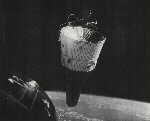
Plate 21: Gemini Rendezvous
Click on Thumbnail to see Full-size image.
During the first Mercury manned orbital space flight, astronaut Glenn reported as follows:
The biggest surprise of the flight occurred at dawn. Coming out of the night on the first orbit, at the first glint of sunlight on the spacecraft, I was looking inside the spacecraft checking instruments for perhaps 15 to 20 seconds. When I glanced back through the window my initial reaction was that the spacecraft had tumbled and that I could see nothing but stars through the window. I realized, however, that I was still in the normal attitude. The spacecraft was surrounded by luminous particles.These particles were a light yellowish green color. It was as if the spacecraft were moving through a field of fireflies. They were about the brightness of a first magnitude star and appeared to vary in size from a pin-head up to possibly 3/8 inch. They were about 8 to 10 feet apart and evenly distributed through the space around the spacecraft. Occasionally, one or two of them would move slowly up around the spacecraft and across the window, drifting very, very slowly, and would then gradually move off, back in the direction I was looking. I observed these luminous objects for approximately 4 minutes each time the sun came up.
During the third sunrise I turned the space-craft around and faced forward to see if I could determine where the particles were coming from. Facing forwards I could see only about 10 percent as many particles as I had when my back was to the sun. Still, they seemed to be coming towards me from some distance so that they appeared not to be coming from the spacecraft.
Reference is here made to Fig. 5, Section 4. We note that the apparent magnitude of the sun-illuminated sphere of diameter 1 mm. at 1 m. is -7. This is in general agreement with the description of brightness given by Glenn who referred to them as looking like steady fireflies.
Observations by astronauts in subsequent flights showed that O'Keefe's interpretation is almost certainly correct. Astronaut Carpenter in Mercury 7 found for example that (NASA SP-6, p. 72).
At dawn on the third orbit as I reached for the densitometer, I inadvertently hit the spacecraft hatch and a cloud of particles flew by the window . . . I continued to knock on the hatch and on other portions of the spacecraft walls, and each time a cloud of particles came past the window. The particles varied in size, brightness, and color. Some were grey and others were white. The largest were 4 to 5 times the size of the smaller ones. One that I saw was a half inch long. It was shaped like a curlicue and looked like a lathe turning.
A modification of the "knocking" technique used by astronaut Carpenter to get the "firefly" effect was used by some of the Gemini astronauts who discovered that a brilliant display resulted from a urine dump at sunrise. The crystals which formed near the spacecraft, when illuminated by the sun, looked like brilliant stars. Plate 22 illustrates the effect (GT-6, Magazine B, Frame 29).
Similar spectacular effects were obtained by venting one of the
on-board storage tanks when the sun was low. One such event is
described by astronaut Conrad (GT-5, tape 269, page 2) speaking to
the ground crew:
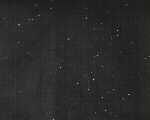
Plate 22: Uriglow
Click on Thumbnail to see Full-size image.
We just had one of our more spectacular sights of our flight coming into sunset just before you acquired us. Either our cryo-hydrogen or our cryo-oxygen tank vented, and it just all froze when it came out and it looked like we had 7 billion stars passing by the windows which was really quite a sight.
The Glenn particles were observed to move with respect to the spacecraft at velocities of 1 to 2 m/sec. Thus the particles and the spacecraft have velocities identical within about 1 part in 4000 in all three coordinates. According to O'Keefe this implies that the orbital inclinations were the same within ±0.01°.
The Rocket Boosters
The rocket booster often achieves orbit along with the primary spacecraft, and can often be seen by the astronauts until the relative orbits have diverged to put the booster out of sight.
Extra-Vehicular Activity Discards
Because of the crowded conditions in the Gemini spacecraft, the usual procedure after completion of extra-vehicular activity (EVA) was to discard all the equipment and material that had been essential to the EVA but was now useless. This material stayed in essentially the same orbit as the spacecraft and was visible to the astronauts after the disposal. An interesting example occurred in Gemini 12 mission when four discarded objects were seen some time later as four "stars" (GT-12., Astronaut debriefing, page K/3, 4).
Lovell:
I did not see any objects in space other than the ones we had put there except for several meteors that whistled in below us during the night passes. I might mention we -- during the last standup EVA we discarded, in addition to the ELSS, three bags, one of which was the umbilical bag and the other had some food in it and the third one had several hoses that we
were discarding. And I pushed these forward with a velocity, I would guess, might be 3 or 4 feet per second. And we watched these for quite some time period until they finally disappeared about 2 maybe 3 or possibly 4 orbits later at sunrise condition, we looked out again and saw 4 objects lined up in a row and they weren't stars I know. They must have been these same things we tossed overboard.
Much has been made of this event by John A. Keel, who apparently thought there was discrepancy between the number of objects thrown out by the astronauts (three) and the number of objects later seen as illuminated objects (four). The pertinent part of Keel's article follows (Keel, 1967):
You never read about it in your local newspaper but during the last successful manned space shot -- the flight of Gemini 12 in November 1966 -- astronauts James Lovell and Edwin Aldrin reported seeing four unidentifiable objects near their orbit."We saw four objects lined up in a row" Captain Lovell told a press conference on November 23rd, "and they weren't stars I know". Several orbits earlier, he explained, they had thrown three small plastic bags of garbage out of the spacecraft. He hinted that these four starlike objects standing in a neat row were, somehow, that trio of non-luminous garbage bags.
A careful reading of the original transcript however shows that four objects were discarded, i.e. the ELSS, plus three bags.
There are three visual sightings made by the astronauts while in orbit which, in the judgment of the writer, have not been adequately explained. These are:
Astronaut McDivitt described seeing at 3:00 CST, on 4 June 1965, a cylindrical object that appeared to have arms sticking out, a description suggesting a spacecraft with an antenna.
I had a conversation with astronaut McDivitt on 3 October 1967, about this sighting and reproduce here my summary of the conversation.
McDivitt saw a cylindrical-shaped object with an antenna-like extension. The appearance was something like the second phase of a Titan (not necessarily implying that that is actually what be saw) It was not possible to estimate its distance but it did have angular extension, that is it did not appear as a "point." It gave a white or silvery appearance as seen against the day sky. The spacecraft was in free drifting flight somewhere over the Pacific Ocean. One still picture was taken plus some movie exposures on black and white film. The impression was not that the object was moving parallel with the spacecraft but rather that it was closing in and that it was nearby. The reaction of the astronaut was that it might be necessary to take action to avoid a collision. The object was lost to view when the sun shone on the window (which was rather dirty). He tried to get the object back into view by maneuvering so the sun was not on the window but was not able to pick it up again.
When they landed , the film was sent from the carrier to land and was not seen again by McDivitt for four days. The NASA photo interpreter had released three or four pictures but McDivitt says that the pictures released were definitely not of the object he had seen. His personal inspection of the film later revealed what he bad seen
It is McDivitt's opinion that the object was probably some unmanned satellite. NORAD made an investigation of possible satellites and came up with the suggestion that the object might have been Pegasus which was 1200 miles away at the time. McDivitt questions this identification.
The NORAD computer facility's determination of the distances from GT-4 to other known objects in space at the time of the astronaut McDivitt's sighting yielded the following tabulation.
| Number |
||||
| OBJECT | Spodats (NORAD) | International (PASS) | Time (C.S.T.) | Distance in km. from GT-4 |
| Fragment | 975 | 2:56 | 439 | |
| Tank | 932 | 3:01 | 740 | |
| Fragment | 514 | 3:04 | 427 | |
| Omicron | 646 | 3:06 | 905 | |
| Omicron | 477 | 3:07 | 979 | |
| Fragment | 726 | 3:09 | 625 | |
| Fragment | 874 | 3:13 | 905 | |
| Omicron | 124 | 3:13 | 722 | |
| Pegasus Debris | 1385 | 3:16 | 757 | |
| Yo-Yo Despin Weight | 167 | 3:18 | 684 | Pegasus B | 1965-39A | 3:06 | 2000 |
The ten objects in addition to Pegasus B in the NORAD list were all at considerably greater distances away from GT-4 than an admittedly crude estimate of 10 miles (16 km.) made by McDivitt, and were of the same or smaller size than Pegasus B. They would not appear to be likely candidates for the object sighted by the astronaut.
2. Gemini 4, moving bright light, higher than spacecraft.
At 50h 58m 03s of elapsed time of GT-4, astronaut McDivitt made the following report.
Just saw a satellite, very high . . . spotted away just like a star on the ground when you see one go by, a long, long ways away. When I saw this satellite go by we were pointed just about directly overhead. It looked like it was going from left to right . . . back toward the west, so it must have been going from south to north.
Although McDivitt referred to this sighting as a satellite, I have included it among the puzzlers because it was higher than the GT-4 and moving in a polar orbit. It was reported as looking like a "star" so we have no indication of an angular extension.
The suggestion at the time of sighting that this was a satellite has not been confirmed, so far as I know, by a definite identification of a known satellite.
Conversations with McDivitt indicate that, on one other occasion, off the coast of China, he saw a "light" that was moving with respect to the star background. No details could be made out by him.
3. Gemini 7, "bogey."
Portions of the transcript (CT 7/6, tape 51, pages 4,5,6) from Gemini 7 are reproduced here. The following conversation took place
| Spacecraft: | Gemini 7 here, Houston how do you read? |
| Capcom: | Loud and clear. 7, go ahead. |
| Spacecraft: | Bogey at 10 o'clock high. |
| Capcom: | This is Houston. Say again 7. |
| Spacecraft: | Said we have a bogey at 10 o'clock high. |
| Capcom: | Roger. Gemini 7., is that the booster or is that an actual sighting'? |
| Spacecraft: | We have several, looks like debris up here. Actual sighting. |
| Capcom: | You have any more information? Estimate distance or size? |
| Spacecraft: | We also have the booster in sight. |
| Capcom: | Understand you also have the booster in sight, Roger. |
| Spacecraft: | Yea, we have a very, very many -- look like hundreds of little particles banked on the left out about 3 to 7 miles. |
| Capcom: | Understand you have many small particles going by on the left. At what distance? |
| Spacecraft: | Oh about -- it looks like a path of the vehicle at 90 degrees. |
| Capcom: | Roger, understand that they are about 3 to 4 miles away. |
| Spacecraft: | They are passed now they are in polar orbit. |
| Capcom: | Roger, understand they were about 3 or 4 miles away. |
| Spacecraft: | That's what it appeared like. That's roger. |
| Capcom: | Were these particles in addition to the booster and the bogey at 10 o'clock high? |
| Spacecraft: | Roger -- Spacecraft (Lovell) I have the booster on my side, it's a brilliant body |
| in the sun, against a black background with trillions of particles on it. | |
| Capcom: | Roger. What direction is it from you? |
| Spacecraft: | It's about at my 2 o'clock position. (Lovell) |
| Capcom: | Does that mean that it's ahead of you? |
| Spacecraft: | It's ahead of us at 2 o'clock, slowly tumbling. |
Many of the engineering problems involved in putting men into orbit would have been alleviated if it had been decided to omit the windows in the spacecraft, although it is questionable whether the astronauts would have accepted assignments in such a vehicle. The windows did make possible many planned experiments but the observations discussed in this chapter are largely sporadic and unplanned. The program of engineering, medical and scientific experiments was sufficiently heavy to keep the astronauts moderately busy on a regular working schedule but left reasonable opportunity for the inspection of natural phenomena.
The training and perspicacity of the astronauts put their reports of sightings in the highest category of credibility. They are always meticulous in describing the "facts," avoiding any tendentious "interpretations." The negative factors inherent in spacecraft observations which have been mentioned in this chapter would seem to be more or less balanced by the positive advantages of good observers in a favorable region.
Duntley, Seibert Q., Roswell W. Austin, J.H. Taylor, and J.L. Harris. "Visual acuity and astronaut visibility, NASA SP-138, (1967)
Hymen, A. "Utilizing the human environment in space," Human Factors, Vol. 5, No. 3, (3 June 1963).
Jacchia, L.G. Philosophical Transactions, Royal Society, London A262 (1967), 157.
Keel, John A. "The astronauts report UFOs in outer space," Flying Saucers -- UFO Reports, Dell No. 4, (1967), 32.
King-Nele, D.G. Theory of Satellite Orbits in an Atmosphere ,London: Butterworths, 1964.
McCue, G.A., J.G. Williams, H.J. Der Prie and R.C. Hoy. North American Aviation Report, No. S 10 65-1176, 1965.
NASA Reports on Mercury and Gemini Flights as follows:
Results of the First United States Manned Orbital Space Flight (20 February 1962). Transcript of Air-Ground Communications of the MA-6 flight is included.NASA SP-6. Results of the Second United States Manned Orbital Space Flight (24 May 1962). Transcript of the Air-Ground Voice Communications of this MA-7 flight is included.
NASA SP-12. Results of the Third United States Manned Orbital Space Flight (3 October 1962). Transcript of the Air-Ground Communications of this MA-8 flight is included.
NASA SR-45. Mercury Project Summary including results of the Fourth Manned Orbital Flight (15-16 May 1963). Includes a transcript of Air-Ground Voice Communication for MA-9.
MA-9 Scientific Debriefing held on (2 June 1963).
Manned Space Flight Experiments Symposium, Gemini Missions III and IV, (18-19 October 1965).
NASA SP-121, Gemini Mid Program Conference, (February 1966). NASA SP-138, Gemini Summary Conference, (February 1967).
Pilkington, J.A. "The visual appearance of artificial earth satellites," Planetary and Space Science, Vol. 15, (1967), 1535.
Quinn, E. and D.G. King-Nele. "Table of earth satellites launched in 1966," Planetary and Space Science, Vol. 15, (1967), 1181.
Roach, J.R., R.E. Hathaway, V.L. Easterly and R.H. Sahlehouse. Final Report, F67-05, Contract NAS 8-18119, (1967), 3-23, 24,25.
Summers, L.G., R.A. Shea and K. Ziedman. "Unaided visual detection of target satellites," Journal of Spacecraft and Rockets, Vol. 3, No. 1, (January 1966).
Zink, D.L. "Visual experiences of the astronauts and cosmonauts," Human Factors, Vol. 5, No. 3, (June 1963).